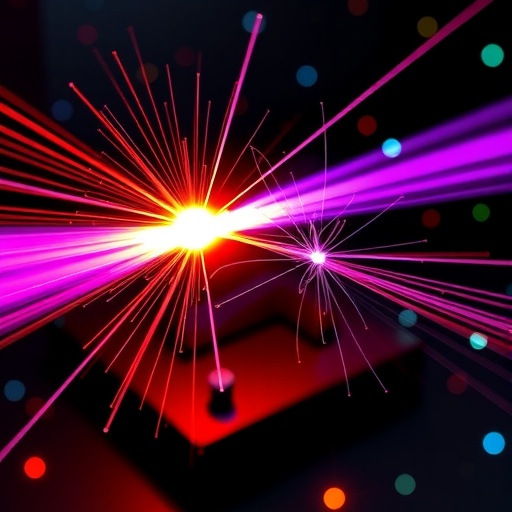In a groundbreaking development in the field of quantum communication, researchers at the National Institute of Information and Communications Technology (NICT) have achieved the world’s first entanglement swapping using sum-frequency generation (SFG) between single photons. This success marks a significant leap forward in quantum information processing, showcasing the potential for more efficient communication systems and expanding the horizons of quantum technologies. By exploiting the unique features of single photons, this pioneering experiment addresses fundamental challenges that have long plagued researchers in advancing quantum communication protocols.
The technique of entanglement swapping has been a subject of theoretical interest for years. Traditionally, it has relied on the probabilistic nature of photon-pair generation and two-photon interference, leading to constraints in distinguishing successful events. This limitation often necessitated additional verification measures, impeding the fidelity of quantum operations. With the introduction of SFG, researchers can now detect generated photons in the process, allowing them to identify successful entanglement swapping events more effectively. By integrating these two methodologies, the NICT team has opened new possibilities for enhanced quantum communications, potentially revolutionizing secure data transfer.
The experimental setup employed in this study utilized an array of state-of-the-art technologies designed to maximize efficiency and minimize noise in the detection of SFG photons. The researchers employed high-speed-clocked entangled photon-pair sources, enabling rapid generation of entangled pairs. Additionally, low-noise superconducting nanowire single-photon detectors were utilized to significantly enhance the signal-to-noise ratio (SNR). These detectors are renowned for their ability to detect faint signals without introducing substantial background noise, thus ensuring the reliability of the results. The culmination of these sophisticated technologies has led to the successful observation of SFG between single photons with a remarkably high SNR, a milestone that had eluded previous studies.
In the past, applying nonlinear optical effects involving single photons has been a substantial challenge. Although the theory suggested they were valuable for quantum communication, practical applications were hampered by the inherently weak nature of nonlinear interactions at the single-photon level. The NICT researchers have effectively harnessed these nonlinear effects to achieve meaningful advancements in quantum operations. This innovative integration not only demonstrates the efficacy of SFG in entanglement swapping but also serves as a guiding light for future developments in nonlinear optical devices and systems.
Upon detecting the SFG photon, the research team was able to discern that one photon was present in each of the participating modes, a realization that is pivotal for confirming the success of entanglement swapping. This breakthrough addresses the previously mentioned limitation of low fidelity in conventional entanglement swapping methods. By ensuring that the successful events can be identified without destroying the resultant entangled state, this new methodology paves the way for applications in loophole-free Bell tests and long-distance device-independent quantum key distribution.
The significance of these findings extends beyond theoretical interest; it promises practical applications that can transform the landscape of quantum communication. The implications are profound, particularly in improving the efficiency of quantum information processing circuits and potentially enabling higher-performance quantum technologies. This research also signals a shift towards miniaturization in photonic devices, ensuring that advances in quantum communication can be integrated into smaller, more efficient systems.
Moving forward, the NICT research team plans to focus on enhancing the SNR further and optimizing the efficiency of nonlinear optics for quantum information protocols. These endeavors are crucial for transitioning from theoretical frameworks to practical applications in quantum communication technologies. Enhancements in these areas will facilitate the development of compact photonic circuits, ultimately extending the range and effectiveness of quantum key distribution.
This pioneering work was published on October 7, 2025, in a leading scientific journal, Nature Communications, marking a significant contribution to the field of quantum mechanics. The ability to conduct entanglement swapping through SFG opens up invaluable paths for further research and exploration within quantum information science. The NICT team has not only broken new ground with this accomplishment but has also laid a foundation for future innovations that will undoubtedly continue to shape the future of quantum technologies.
Overall, the implications of this achievement resonate deeply within the scientific community. By effectively demonstrating the use of nonlinear optical effects between single photons for entanglement swapping, the researchers have provided a powerful tool that could lead to unprecedented advancements in quantum communication. As the field of quantum information processing continues to evolve, the work conducted by the NICT team serves as a pivotal reference point, ushering in a new era of efficient, reliable, and secure quantum communications.
In conclusion, the discovery and successful implementation of entanglement swapping via SFG not only addresses long-standing challenges in the field but also paves the way for transformative applications in the realm of quantum communication. It emphasizes the vital role of research and technological advancements in realizing the full potential of quantum technologies. This achievement signifies a monumental step forward in our journey toward harnessing the intricate properties of quantum mechanics for practical applications, highlighting the tenacity and innovation of the scientific community driving this exciting frontier.
Through these milestones, researchers clarify that the fusion of theoretical principles with cutting-edge technology is not just a path to discovery but also a roadmap to future applications that promise to reshape our approaches to secure communication and information processing on a quantum level. The variations and potential expansions on this work could lead to unfathomable advancements in our capabilities to utilize quantum mechanics for enhanced communication strategies, potentially influencing a myriad of technological fields.
Subject of Research: Quantum Information Processing
Article Title: Experimental Entanglement Swapping through Single-Photon χ(2) Nonlinearity
News Publication Date: 7-Oct-2025
Web References:
References:
Image Credits: National Institute of Information and Communications Technology (NICT)
Keywords
Quantum entanglement, Quantum mechanics, Quantum optics, Quantum information science, Telecommunications, Photons.
Tags: challenges in quantum communication systemsenhancing quantum communication protocolsminimizing noise in quantum experimentsNICT quantum research achievementsphoton-pair generation techniquesquantum communication breakthroughsquantum entanglement swappingquantum information processing advancementsrevolutionary quantum technologiessecure data transfer innovationssingle photon detection methodssum-frequency generation of single photons





